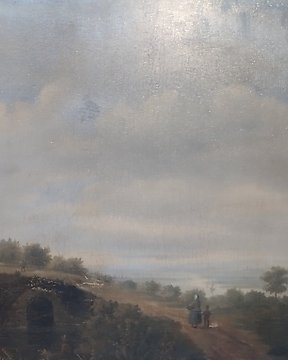
P.J Malliart (1764-1856) - Destroyed village after the war
Nr. 81899417

Nr. 81899417

philippe-Joseph MAILLART 1764-1856 Belgian artist who painted paintings on the theme of destroyed buildings after hostilities, very little is known about the artist, this is the Belgian school of artists, only three paintings by this artist were sold at open auctions, the painting is very interesting becausemany small details are depicted in the picture, peacetime after the war is indicated, a hunter is visible somewhere, a fisherman sits unnoticed near the lake, somewhere in the distance a boat sails. the picture shows complete peace and tranquility, and even the war could not destroy, and there is always life after the warThe picture carries with it a great deep meaning.
in the 16th century, Antwerp became the most important trading city in the Burgundian Netherlands. Artists joined the Antwerp Guild of St. Luke in order to be able to practice their profession in the city.
This guild guaranteed the quality and education of young talents. artists first had to train with a master as an apprentice. Young students had to do chores such as mixing pigments, dyeing curtains, and studying.
the first school of artists to emerge in the city were the Antwerp Mannerists, a group of anonymous late Gothic artists active in the city from about 1500 to 1520. They were followed by Mannerist artists of the Italian tradition, who often studied in Italy. this development occurred from 1550. Jan Gossaert was an important representative of this movement, and other artists such as Frans Floris de Vriendt also painted in this style.
The Iconoclasm of 1566 led to the destruction of many works of religious art. the reconstruction and redevelopment of churches and monasteries gave new impetus to the development of painting. Artists such as Otto van Veen and members of the Franken family, who worked in the late Mannerist style, painted numerous altarpieces to replace destroyed and disappeared works. The fall of Antwerp in 1585 marked the beginning of the city's economic decline.
In the 17th century the city experienced an artistic renewal. The great workshops of Peter Paul Rubens and Jacob Jordaens, as well as the influence of Anthony van Dyck, made Antwerp a center of Flemish art. the city was an internationally important publishing center and produced a huge number of Old Master engravings and book illustrations. The Baroque style of the Antwerp School became the dominant style in the Southern Netherlands and is known as Flemish Baroque.
canvases of the Antwerp school are still in great demand, and paintings at auctions are a guarantee of success.
Cum să cumperi de la Catawiki
1. Descoperă ceva special
2. Plasează cea mai mare ofertă
3. Fă o plată sigură